A Minor History Of / Aquatic Ambulism
The sport of God
Joshua Foer
“A Minor History Of,” a column by Joshua Foer, investigates an overlooked cultural phenomenon using a timeline.
ca. 150 CE
Though Jesus and Saint Peter are by far the most
famous aquatic ambulists, they are by no means the only. In A True
Story, the Greek satirist Lucian describes a race known as the
Corksoles: “We saw numbers of men walking on the sea; they were like
ourselves in shape and stature, with the one exception of the feet,
which were of cork.” In another of his works, Lover of Lies, he
writes of a mythical Hyperborean water walker, who some biblical
scholars argue may have inspired the Jesus narrative.
1475–1480 CE

Leonardo da Vinci coins the phrase “water shoes” to describe a pair of elongated animal skin floats sketched in the Codex Atlanticus.
1636 CE

One of the earliest accounts of mechanically aided aquatic ambulism can be found in Daniel Schwenter’s Deliciae Physico-Mathematicae. The man in the illustration struts confidently through the seas wearing what are described as Windhosen and Flossfedern—air pants and winged paddles around his ankles. Leibniz claimed to have witnessed a demonstration of this device, or one like it, on the river Seine in Paris sometime around 1675.
1676 CE

Publication in Japan of the Bansenshukai, a multi-volume handbook of secret ninja knowledge. A section of the handbook is devoted to the art of skating across shallow water using a circular shoe originally developed by rice farmers and known as mizugumo. Ninjas are also trained to walk on water by attaching small floating pots known as ukidaru to their feet.
1785 CE
Agostino Gerli, the noted Italian interior designer and amateur balloonist, publishes a twenty-four-page pamphlet describing a water-walking contraption known as the Ermamfibio.
1858 CE
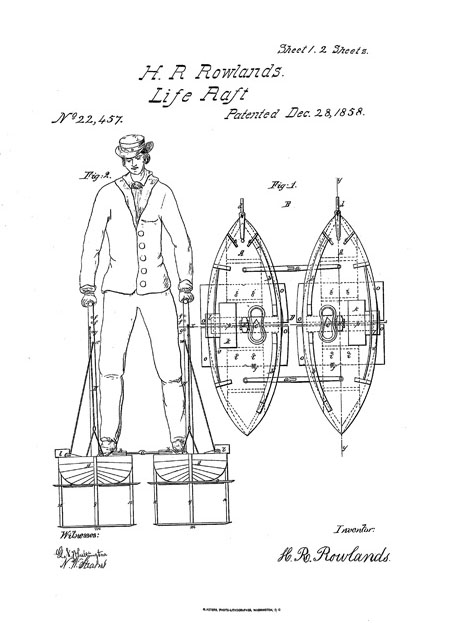
Henry Robert Rowlands of Boston files the first American patent for “An Apparatus for Walking on the Water.” The device consists of small boats that are attached beneath each foot, with handrails to maintain balance. Developments in “water shoe” and “water skate” technology—more than a hundred US patents at last count—have more or less continued upon this trajectory ever since.
1885 CE

British engineer Osborne Reynolds describes the phenomenon of dilatancy, a property of non-Newtonian fluids that have the curious property of hardening when shaken. The best-known dilatant in use today is a suspension of cornstarch in water known as oobleck, after a fictional green slime that appears in a 1949 Dr. Seuss book. Intrepid water-walkers have been known to fill small swimming pools with the fluid, which becomes solid under the pressure of their feet.
ca. 1900 CE

German chocolate company Hildebrands issues a series of twelve whimsical trading cards envisioning life in the year 2000. In addition to personal airships, weather control devices, and undersea tourist boats, the chocolatiers imagine that in the distant future people will be able to take casual strolls on the surface of the water. (Courtesy Bob Coalbran/The Card Mine)
1917 CE
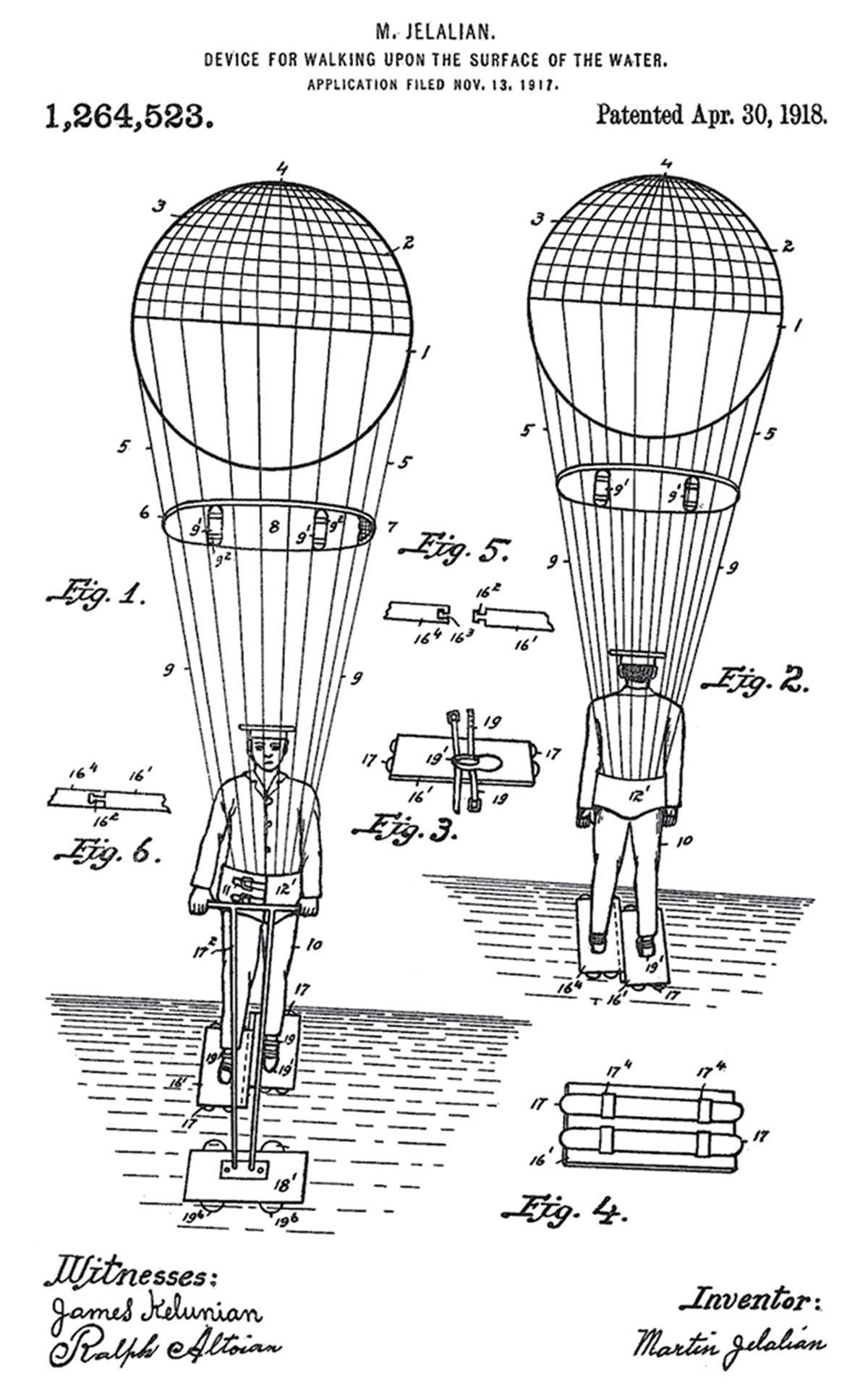
Martin Jelalian of Cranston, Rhode Island, attempts to resolve the problem of dynamic instability that has plagued all previous attempts at aquatic ambulism by harnessing himself to a gas balloon to provide extra buoyancy.
1958 CE
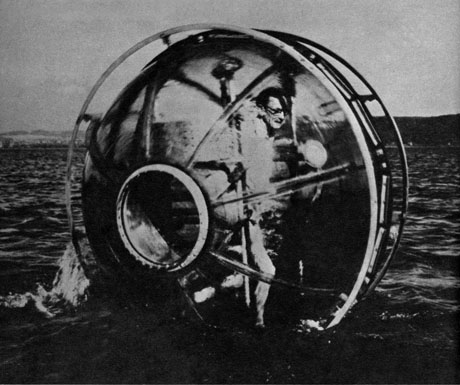
Wayne Wilson, an engineer from York, Pennsylvania, walks across water in a plastic squirrel cage of his own design. (Courtesy Charles Shopsin)
1962 CE
Noted Russian chemist Boris Deryagin announces the discovery of a new “anomalous” form of polymerized water, instigating one of the most bizarre episodes in the annals of modern science. Deryagin’s so-called “polywater” reportedly has vastly different properties from standard H2O, including a much higher viscosity, and could conceivably be a substrate for aquatic ambulism. Over the next decade, dozens of papers on polywater are published in top scientific journals. The New York Times enthusiastically promises that, “a few years from now, living room furniture may be made out of water.” However, in 1970, the true nature of polywater is discovered. Deryagin had inadvertently allowed his equipment to become contaminated with organic compounds, including phospholipids: the renowned chemist had failed to control his own sweat.
1975 CE
Walter Robinson, a twenty-nine-year-old American soldier, walks the fifty-two miles from the Pacific Ocean to the Atlantic Ocean through the Panama Canal on water shoes of his own invention. Self-described as a “world authority” on water-walking and author of the self-published book The Water Shoe: A Serious Work, Robinson would go on to cross the twenty-two-mile English Channel in 1978. Pondering the meaning of aquatic ambulism, Robinson writes, “Can we dream the impossible and build the unthinkable? Walking on water is the sport of God, an expression of space,
a movement to tranquility. Walking on water is a dance with our aquatic mother.”
1984 CE
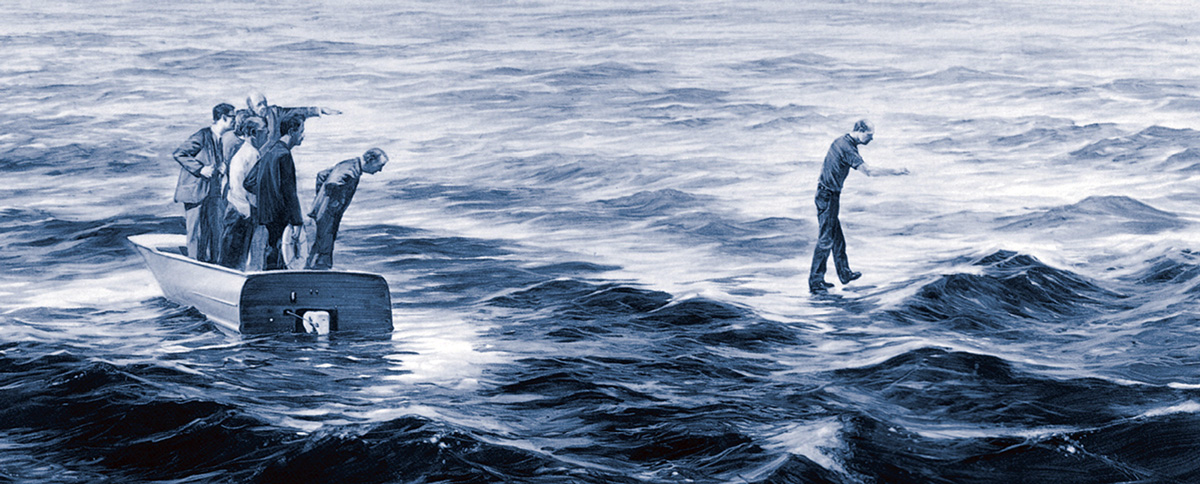
1996 CE
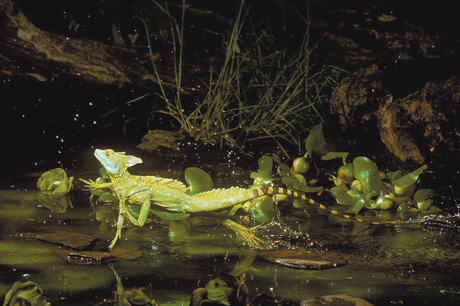
Harvard researchers Thomas McMahon and Jim Glasheen explain the subtle biomechanics of the common basilisk, or “Jesus Lizard,” the largest water-walker in the animal kingdom. Based on their kinematic model of the basilisk’s leg-slapping motion, the researchers estimate that humans would need to achieve speeds on the order of thirty meters per second, requiring more than fifteen times their available muscle power, in order to run across water. (Photo Joe McDonald)
2004 CE
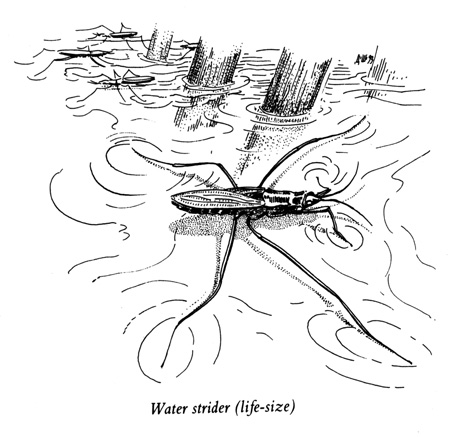
As with flying and swimming, water-walking has evolved independently in multiple lineages, including lizards, mammals, birds, insects, and chelicerates. Each employs its own unique technique. Biophysicists at the Chinese Academy of Sciences discover that the water strider, or “Jesus Bug,” (shown in the drawing above) is able to skip across the water’s surface by capturing small bubbles of air in the hairs beneath its feet.
2005 CE
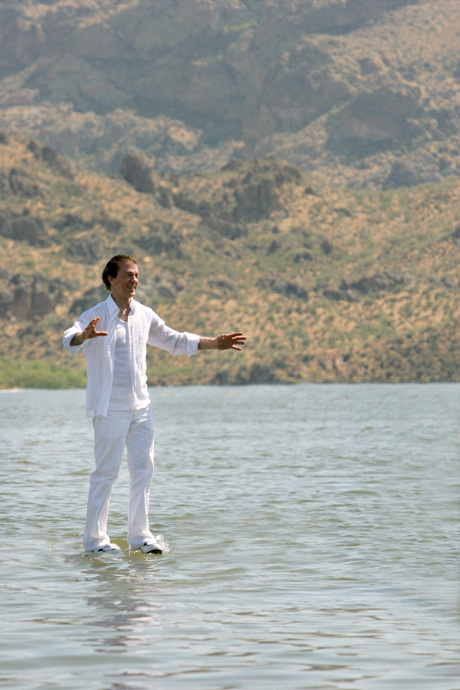
Evangelical Christian magician André Kole walks on Saguaro Lake, near Phoenix, for The Miracles of Jesus, a Discovery Channel documentary. His purpose, he says, is not to prove that Jesus was an illusionist but rather to demonstrate just how hard it would have been for Jesus to have fooled his disciples. (Courtesy André Kole Productions)
2006 CE
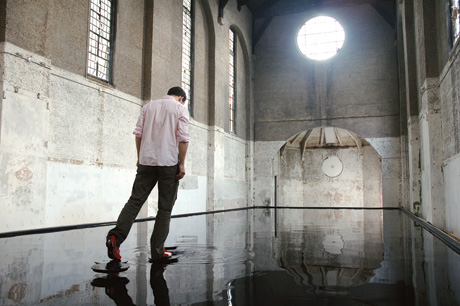
For an artwork titled Bridge, British artist Michael Cross floods Dilston Grove, a London church-turned-gallery and places a series of invisible mechanical platforms just beneath the surface of the water. The weight of a foot placed on a platform elevates the next platform to water level, thus making it possible to experience the sensation of walking on water. (Courtesy Michael Cross)
2006 CE
Doron Nof, an oceanographer at Florida State University, publishes a paper in the Journal of Paleolimnology attempting to explain how Jesus accomplished his miraculous water-walk. Nof suggests that a combination of rare atmospheric conditions between 1,500 and 2,500 years ago and the presence of salty springs on the western shore of freshwater Galilee may have caused isolated patches of the lake to occasionally freeze. It is possible, the scientist argues, that Jesus walked on ice, not water.
2006 CE
Franck Kabele, a thirty-five-year-old evangelical preacher in Libreville, Gabon, promises his congregation that he can walk on water. He wades into the Komo Estuary and promptly drowns.
Joshua Foer is a freelance science writer. He is working on a book about the art and science of memory, forthcoming from Penguin.
Spotted an error? Email us at corrections at cabinetmagazine dot org.
If you’ve enjoyed the free articles that we offer on our site, please consider subscribing to our nonprofit magazine. You get twelve online issues and unlimited access to all our archives.